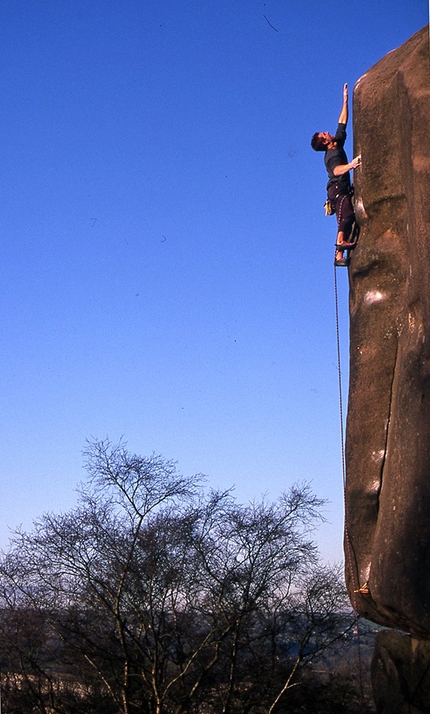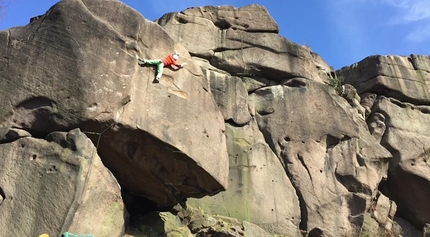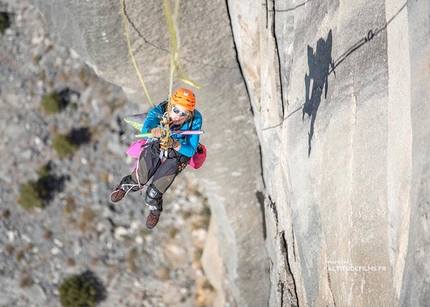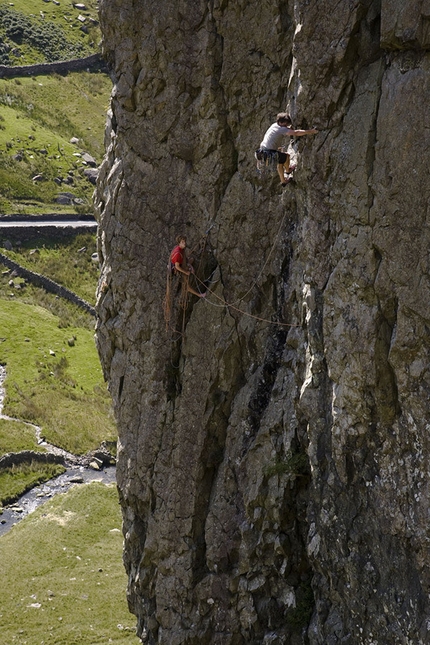James Pearson & Caroline Ciavaldini: the Black Rocks Hard Grit interview
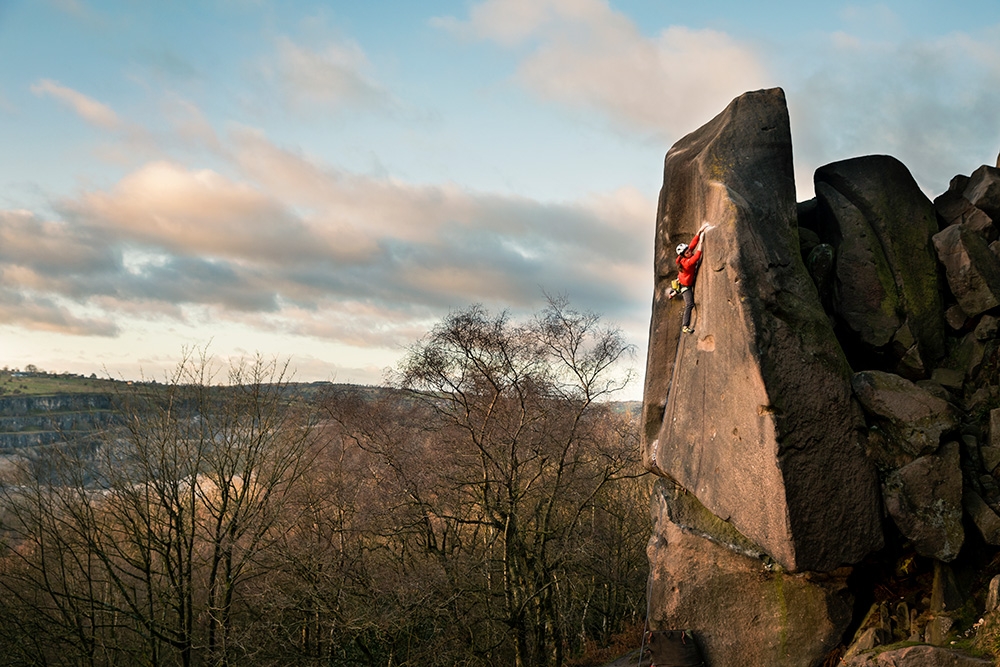
 1 / 7
1 / 7 Chris Prescott / Dark Sky Media
Chris Prescott / Dark Sky Media
Last week James Pearson and Caroline Ciavaldini made back-to-back repeats of two of Britain’s most emblematic gritstone trad climbs, Harder Faster (E9 6c) and Gaia (E8 6c) at Black Rocks. The former was first ascended in 2000 by Charlie Woodburn and repeated only once previously, by Toby Benham in 2003, while after Johnny Dawes’ first ascent in 1986 only two other women had climbed Gaia, Lisa Rands in 2006 and Katy Whittaker in 2013.
James, gritstone is "your cup of tea"
I grew up climbing on the Grit, so it’s definitely the rock I feel the most comfortable on. It’s a really particular style of climbing, which is sometimes best explained by telling people there are not really holds to pull on, just features to move around. Gritstone is a really beautiful rock to look at, and it creates some stunning lines (one of the best being Gaia). It demands a lot of technical ability and mental control, but the routes are rarely very physically difficult, and almost never ever pumpy. This actually caused me quite some problems a few years into my climbing career: having reached a pretty high-level but climbing almost exclusively on gritstone, I struggled with the realisation that if I wanted to climb hard routes elsewhere I really needed to go back to the drawing board and work on my fitness and endurance. Still to this day, climbing hard overhanging sport routes is something I really struggle with, and so yes, it’s definitely nice to come home to the Grit every now and again, and feel like I can float once again.
What makes the climbing here particular
Apart from the visual purity of the lines and the quality of the actual rock, Trad routes on the grit are more often than not dangerous, and it's quite normal, even in easy routes, to climb with the knowledge that broken bones or worse are waiting for you should you fall… The cliffs are never very high, but this actually makes them more dangerous as you only have to do a small amount of climbing above your last piece of protection to be looking at a ground-fall! It’s a special challenge to be able to climb at your best knowing that failure is not an option, and probably closer to the feelings you find whilst mountaineering, rather than sport climbing.
So when was the last time you climbed hard on the grit?
The last time I climbed a hard and dangerous route on the gritstone would probably be 2008 or 2009. I returned a few times since then, and I have even done a couple of pretty hard routes (Gerty Berwick at Ilkley, and The Elder Statesman at Curbar) but these are the exception to the rule of hard grit where the difficulty outweighs the danger.
Why Harder Faster?
Mainly because Caroline wanted to try Gaia, the classic E8 from Johnny Dawes that shares the same start. I thought we could work on the routes together, taking it in turns climbing whilst one of us was looking after Arthur at the base. I actually already knew quite a lot about the route because I belayed my old friend Toby Benham on it in 2003. Toby’s ascent was the first and only repeat of this route, and as I’d tried it briefly whilst he was working on the line, I had a good idea of why it actually entails. Belaying him was really terrifying, even if his ascent went perfectly, as I knew how terrible the sloper was at the top felt and also how it would be impossible to get yourself out the bad situation should you find yourself in one!
First ascended by Charlie Woodburn in 2000 and with only Benham’s early repeat, what has this route come to represent in the last two decades?
The ultimate Hard Grit experience. It’s not necessarily the hardest set of movies I’ve ever done on a Hard Grit route, but it is hard, and it is insanely committing. There is a crux section of 4 or 5 moves at the top where you have no chance of avoiding a ground floor should you slip. With nothing but terrible slopers and smears, it’s impossible to pull harder if you feel like things are going wrong. You need to be perfect every time, have clean, dry skin, take the holds in exactly the right place, and even then you can’t be sure that a little bit of sand or dirt hasn’t blown onto the holds! A terrifying prospect indeed! Charlie Woodburn has always impressed me as a climber who is able to climb very dangerous routes quite close to his physical limit! An excellent, talented, technical climber, he’s repeated and established a few of his own Hard Grit routes, of which Harder Faster is his masterpiece and, in my opinion, one of his finest climbing achievements.
Back in the early 2000 you were on top trad form. Why didn’t you try to climb it then?
I prefer to climb dangerous routes where the holds are relatively good, even if that means the moves might be a little bit more physical. Routes like that are much more controllable, and I like to know that I could possibly pull harder or dig a little bit deeper if necessary when I’m on the sharp end. As such, I’ve always avoided routes like Harder Faster or some of the other pure slab friction climbing routes, even if they might not carry as "big" grades as some of the other routes I’ve climbed in the past!
So how did you approach it now?
The first thing I had to do to repeat Harder Faster was to really clean the slopers on the slab at the top of the route. As you could probably imagine, with only two ascents in 20 years the holds were a little bit dirty! Don’t get me wrong, there was no moss or anything, but there was definitely a very, very fine covering of lichen, just enough to slightly change the shade of the colour of the rock. Before cleaning I could feel tiny, almost microscopic particles crumble under my fingers that gave the impression that the holds were just a little bit sandy. It’s the kind of thing that really wouldn’t make too much difference to climbing, even on a hard-ish boulder problem, but considering the impossibly high consequences of falling off of these holds, I really wanted to have everything stacked in my favour.
Then you tried it on toprope?
Yes, after this I started top-roping the line, first of all working out the individual moves, then deciding on the most efficient sequence. I then started to try to link the whole sequence together, and finally practiced climbing the sequence over and over and over again, often in less than perfect conditions, forcing myself to pause on all the holds and doing silly things like cutting my feet on the crux moves. Basically forcing myself to climb really, really badly, to know that I had a big enough margin to risk climbing this route. I say "risk" because this route is seriously dangerous, much more dangerous than I thought I would allow myself to try since becoming a father. It’s really hard to know exactly why I was attracted to this challenge in the first place, but once I decided that I might be interested to lead it, I knew I had to do absolutely everything I could possibly do to make sure that nothing would go wrong.
What did it feel like pulling on those final slopers? They look absolutely terrifying!
The first time I tried to pull onto those slopers, I couldn’t hold them for even a split second. Like I said in the beginning of this interview, Grit isn’t really about climbing on holds, but about using features, and up there there are no holds, just a big slopey slab. You have to feel around, almost like reading braille, and discover the subtle differences in the surface of the rock, then once you know where these special places are, you figure how to hold your body under them. Sometimes you squeeze with your fingers, sometimes you allow your weight to pull on the friction of your palm, but little by little you unravel the mystery, and something that seemed impossible just a few moments before actually becomes by quite easy.
Did you toprope it clean before your lead?
Actually I never top-roped the whole line in one try from the floor, but I did climb the entire upper section just after the gear placement many, many many times on a static line. I like to practice routes on the Grit on a static for a few reasons, firstly because you don’t need a belayer focused on you all the time, perfect for our situation with young Arthur. And secondly, if you can climb the line pulling through the slack on the static, you know that you have more than what it takes to climb the route on the lead. For me, dangerous routes are all about control. I need to show myself that I can climb it in any sort of situation, to know that if I were to fall off, it will only be because I made some sort of ridiculous error. In the past I might have top-roped a route like this a few times before feeling comfortable enough to lead it, but this time, as a father, I needed to know that I was so far above the level of the route that there was basically no chance of me falling on the lead. Still, even with that knowledge, a lot of soul-searching and questioning had to happen before I decided that it was a good idea.
Last time we spoke, after your repeat of Jacopo Larcher’s Tribe at Cadarese, you said you hadn’t ruled out hard trad, but mentioned that with fatherhood you’d weigh up the pros and cons. Unlike Tribe though, this climb is the very opposite of difficult and safe…
Yes, Harder Faster is the exact opposite of the style of Tribe. In Tribe you start every attempt wondering if maybe this is the one where you will have enough strength, technique and focus to get to the top. For Harder Faster, you wait until the perfect moment where everything seems to align, and set off for your one try knowing that if you fall you might never make another. I honestly didn’t imagine myself climbing like this after becoming a father, yet for one reason or another I find myself here. I can’t tell you 100% that I think it was a good idea, and I’d be lying if I said I knew 100% that it would work out alright. What I can say is that I prepared myself as well as I possibly could using all the skills I’ve developed over the last 20 years, and did everything I could to make leading the route as safe as it could be. In general I took far more time to prepare and commit to this challenge than bold routes I've climbed when my life was basically only my own, and so somehow, perhaps it was maybe justifiable?
How was the lead?
The day of the lead was pretty complicated with the weather, it was bitterly cold in the morning and both Caro and I really struggled to warm up. Finally, once we felt ready to go for our respective leads on the route - Caro had actually gone up and placed the gear and was waiting to start the hard section- it started snowing, and within a matter of seconds you could see the top slopers on both routes getting wet. We almost gave up and went home but then the snow stopped, the skies turned blue and everything seemed on again. When I went for the lead, everything felt better than perfect, with the exception of a lot of rope drag, caused by my attempts to keep the gear extensions as short as possible! Even with this horrible drag, I felt so solid on the route that I could pull up some slack in the middle of the crux to give myself enough freedom for the little dynamic mantle at the top. During the climb I felt nothing but peace. Pure serenity, a total detachment from reality. It’s been many years since I felt that from climbing, and it made me remember why all those years ago I loved dangerous routes like this.
Caro your turn! That was a big, big lead! Gaia is steeped in history!
Indeed, thats’s a very big little route ;-)
Perhaps your most dangerous lead to date?
Hard to say really. I think I have been in dangerous situations before, in Ethiopia this year for example, but there we were talking of adventure climbing. While English trad, as people say, is sort of designed danger: the only unknown is you own mind. I think over the year, I have learned to handle danger, which is why I was ready for Gaia now.
James grew up on the grit, you on limestone. Tell us about your relationship with what the Brits call "God’s own rock"
I vividly remember the first years that James brought me to the Peak. To be honest I was a comp rat, so I hadn’t heard much about climbing in the area. I wasn’t familiar with the saying God’s own rock, and I came with very low expectations; all I wanted was to understand James and what he was about a bit better. The crags are very small and, at first, quite underwhelming. James showed me Equilibrium, I even abseiled down it… Until you actually begin to imagine yourself on a lead attempt, it’s nothing special. But then, doing hard, balancy and moves so dependent on friction with not enough gear under you… it suddenly transforms into a game that I knew nothing about, and that seemed simply mad to me. “Why would anyone want to put themselves into such a stupid situation?” is what I kept asking myself. So I spent several years thinking that gritstone was nothing special, just an ersatz for the UK as they had so little rock… But now, with more experience in bouldering, I have come to fully enjoy its exceptional quality. I used to hate balancy moves because I was bad at it. I am still not great, and I am still quite frightened on arêtes but, put simply, I now agree that "God’s own rock" has no equals.
Lisa Rands did the first female ascent in 2006… That was quite a step!
I can imagine it was ! To have the vision to be the first female on hard dangerous routes is always a difficult step. Especially Gaia is a very different game if you are small. At the time I paid no attention to such a feat, but with a wider view now, I can really see how Lisa opened a new path for female climbers, which Katy then impressively followed in 2013!
When did the idea first spring to mind and how did you go about it?
Gaia is the very first trad route that I saw on video. I had met James, and he told me he was a Trad climber. I didn’t know that word "Trad". You have to imagine that back then I was a competition climber, focused on my own world. So I googled Trad, and stumbled across a video of Jean-Minh Trinh-Thieu falling off Gaia and nearly breaking his leg. I was horrified! I never, ever thought of even putting my hands on such a route! I guess from then on, Gaia represented the Trad that I didn’t have the guts to climb and that was too stupid for me.
And yet you returned to the Earth Goddess
It is 10 minutes away from James’ parents’ home, and just before the Quarryman I tried Gaia on a static rope. I wanted to imagine myself being afraid. Somehow it was part of my journey to prepare myself for the Quarryman. So that was two and a half years ago. I found the moves really quite difficult, and the prospect of finding myself on those slopers with that gear so far below me was really scary. At that point, I still didn’t want to do Gaia. I didn’t want to put myself is such a position, ever! We came back at the end of this year and I wanted to go in Gaia again. I didn’t have specific plans but I knew that I was back in my best shape after having a baby, having just climbed 8c again. I got on the route again, figured out all the moves, and little by little began to imagine leading it. It does definitely help that I am walking in Lisa Rand’s steps and Katie Whittaker’s as well. It helps to know that a woman has done it before me.
What was the hardest for you?
The hardest move for me is the boulder at the lip. If you are tall enough, it isn’t hard at all. I know Lisa Rand did it by locking on the two finger pocket, I did something similar, with a left heel hook. It took me a while to figure out a method that would work for me! Then for the move on the right, I first right-hand palm to move my feet out of the groove, then match the sloper, and throw my right foot onto the arête for a toe hook. You’d better master that section completely, because it is above the "safe" zone and you would need an extraordinary belayer to save your ass from hitting the floor. With that hook far out right, you might fall horizontally if your hand slipped. Really not an option at that point!
How did your lead go?
I only decided to commit for the lead when I knew that I was very strong on the top moves. I never slipped from the arête zone on toprope, even on my warm-ups. I spent several days visualising how I would feel up there, and how I could control my emotions.
And how did you feel?
I definitely loved the lead. I was mainly afraid of finding myself in the scary spot and hating myself for being there. Which wouldn’t have made sense, after all, the only reason I was trying Gaia is because I wanted to. So, I wanted to love not only the mental preparation process, but also the act of leading the climb. While on the route, I managed to control my emotions entirely, to focus on nothing but the moves. I purposefully didn’t look down, so I wouldn’t have a reason to freak out. I wanted to do Gaia because I wanted to experience that mental control. I have being in similar positions in competitions, but back then then it was simply a fear of failing, not falling. This fear you experience with trad is associated with the risk of hurting yourself, and I did whatever was needed to reduce this. And I have to say the lead was an exceptional moment. Maybe like a drug, but more of a serenity drug.
With La Sportiva



 Copia link
Copia link
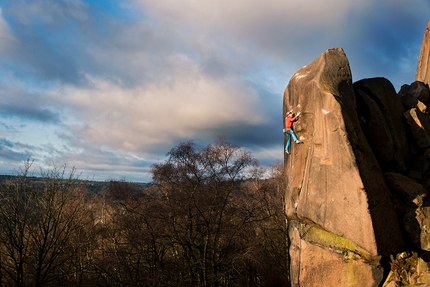
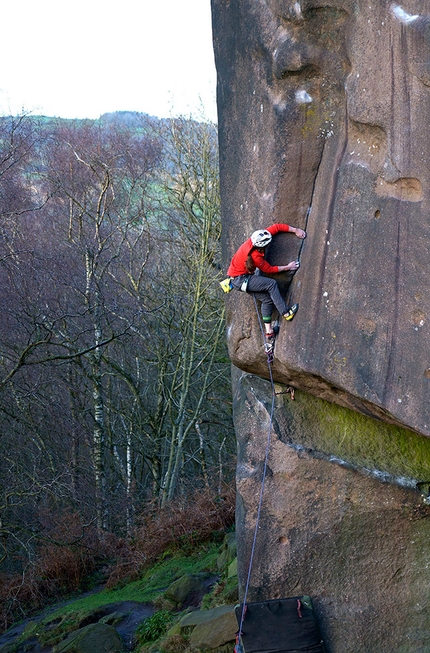
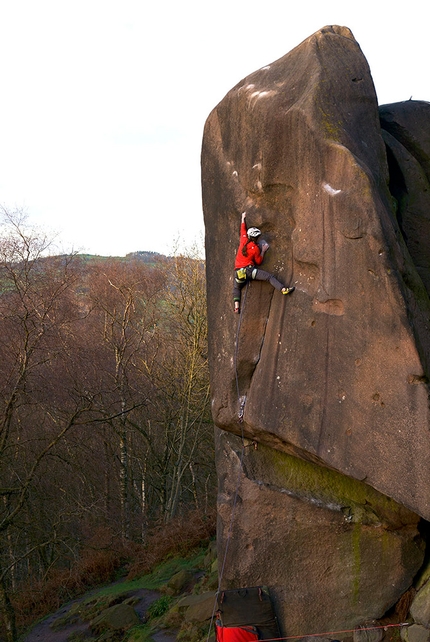
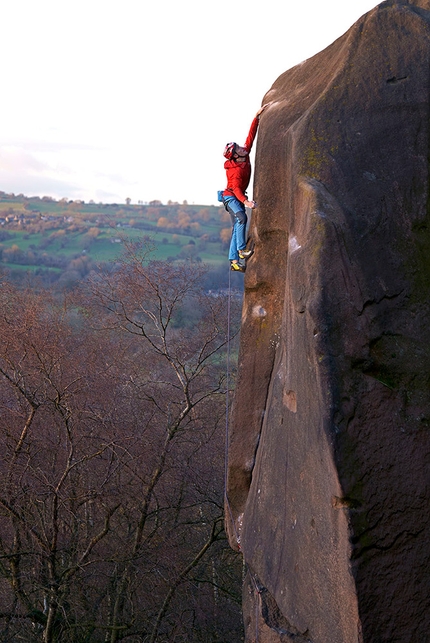
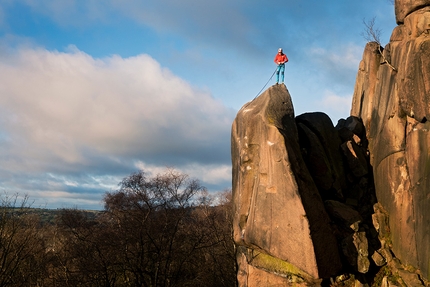
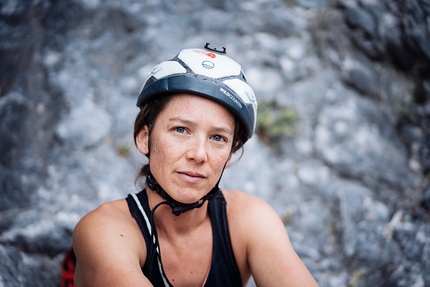
 See all photos
See all photos